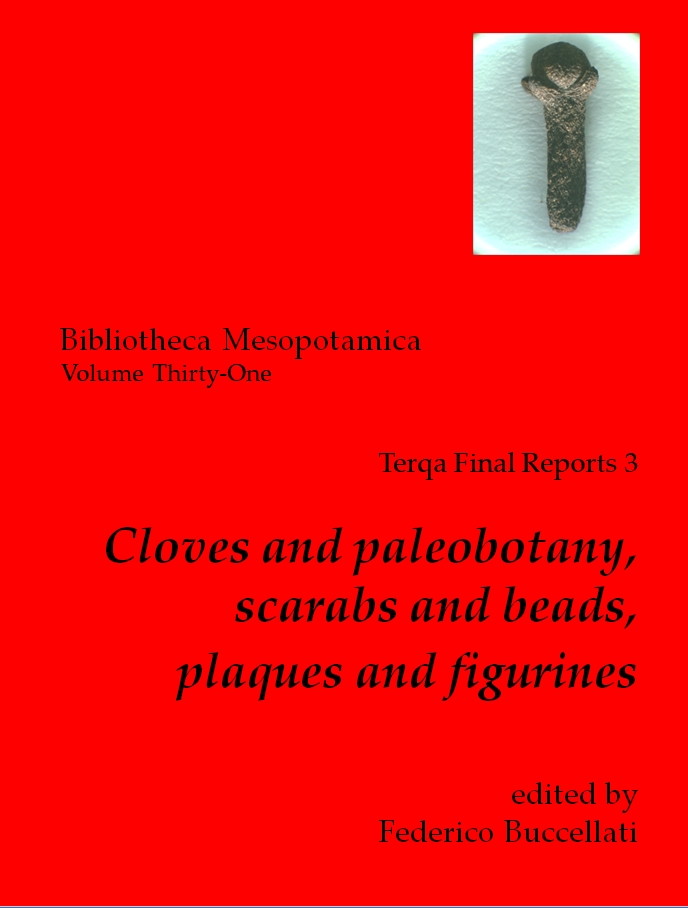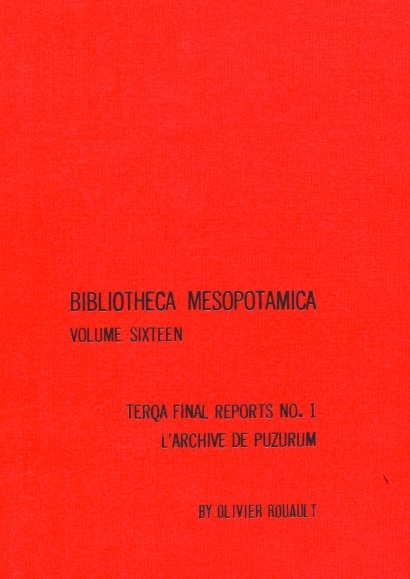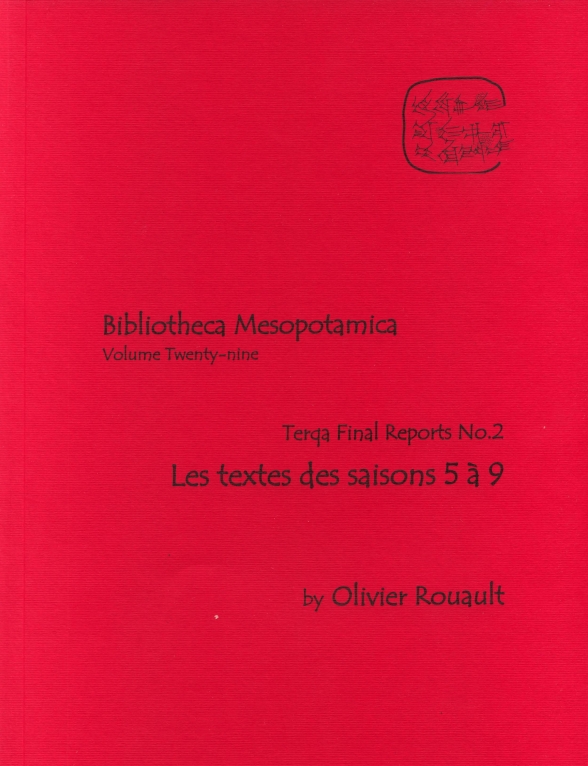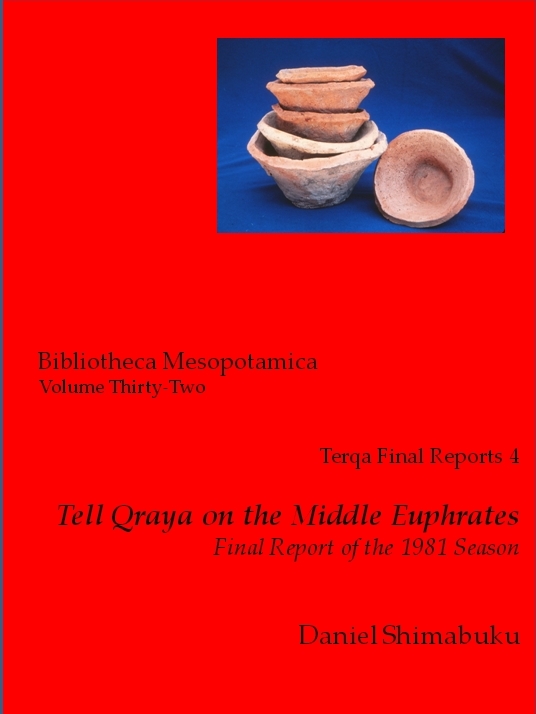|
Home |
Introduction |
Narrative |
Database |
Texts |
eLibrary |
Audio-visuals |
Indices |

|
Terqa Electronic LibraryTerqa Final Reports
|
Introduction TFR: Final Reports TPR: Preliminary Reports Articles and monographs Newsletters and short notices |
|
TFR 1 3 MB Back to top |
1984 | Olivier Rouault L'Archive de Puzurum Bibliotheca Mesopotamica, Vol. 16  |
Abstract The first volume of the Terqa Final Reports is the con~plete publication of an important archive of tablets of the Khana period. The texts were excavated in the third and fourth seasons, from a room of a private house which had been burned in antiquity. The archive consists of twelve tablets, many with clay envelopes, including a rare example of a double envelope. A large number of fragments were also found, all of which are published here. Ten of the tablets are legal contracts, and the designation of a man by the name of Puzurum as buyer in seven of these has led to his identification as owner of the archive. Two other texts included in the publication, a mathematical text and a dedicatory stone pendant, were not from the archive itself. Overall, the archive presents a significant picture of some legal and economic aspects of the second quarter of the second millenniunl B.C., as they applied to individual transactions, and is also important in shedding new light on the chronology of the Khana period. Most of the tablets are dated to king Yadih-Abu, for whom we otherwise have a synchronism with Samsu-Iluna. |
|
TFR 2 38 MB Back to top |
2011 | Olivier Rouault Terqa: les textes des saisons 5 à 9 Bibliotheca Mesopotamica, Vol. 29 Shelby White - Leon Levy Program for Archaeological Publications 
|
Abstract This volume presents the publication by O. Rouault of the epigraphic documents discovered in the 5th through the 9th season of excavations at Tell Ashara-Terqa (Syria). The total of 97 documents, found in Areas C and F, is unevenly distributed between the five seasons of excavation (respectively 17, 6, 20, 24 and 30). Three periods are represented: Old Hana (Area C), late Šakkanakku and Old Babylonian (Area F). The ten documents of the Šakkanakku period – legal and administrative – present data that are rather new: they illustrate the specificity of the scribal tradition during this period, but at the same time they show that some characteristics of the legal Old Babylonian documents find their origin there. Of the 62 Old Babylonian documents, around 20 are of administrative type (management of workers, various distributions, recording of the production of fields, etc) and ten are letters. Two legal texts are particularly interesting: a contract of division of heritage and a report of a lawsuit mentioning the governor Kibri-Dagan and the royal judge. School texts and a literary fragment written in emesal dialect show that a high level scribal school functioned at Terqa at that time. Lastly, a fragment of a divinatory report and allusions in the letters give information on these types of activity. Among the 27 texts of the time of Hana, we find the same typology: administrative documents and letters, school, legal and religious texts, this last category being represented by a list of offerings to the goddess Ninkarrak, found in her temple. The work presents first all the texts, season by season, in transcription and translation. Exhaustive indices are given, along with an analytical table where the texts are sorted according to chronology and typology, allowing a thematic approach to the collection. After the bibliography, the documents are presented with hand copies and photographs given side by side. |
|
TFR 3 Front matter Back to top |
forthc. | Federico Buccellati, editor Cloves and paleobotany, scarabs and beads, plaques and figurines Bibliotheca Mesopotamica, Vol. 31 Shelby White - Leon Levy Program for Archaeological Publications 
|
Abstract The book is dedicated to small finds, two of which, the cloves and the scarabs, are of particular importance. The cloves are, indeed, a very small find which, for all its diminutive size and lack of spectacularity, is of great import for its historical implications. It has also been cited often on the basis of our preliminary reports. It is published here in full, with regard to botanical analysis (K. F. Galvin) and stratigraphic setting (G. Buccellati). The rest of the botanical samples are also published. A small group of scarabs sheds light on wide range connections in the early second millennium (A. Ahrens). They were found together with a large group of beads in a cahce stored next to the altar in the cella of the Temple of Ninkarrak (M. Stancavage). The figurines (G. Areshian) and plaques (M. Kelly-Buccellati) shed light on a dimension of everyday life that is particularly well documented at Terqa, both typologically and stratigraphically. A detailed publication of the documentary evidence includes an analysis of their functional and stylistic peculiarities. The site of Qraya, dating back to the Proto-literate period, can be seen as the mother site of Terqa, which begins in the Early Dynastic period and is situated just downstream of Qraya. We report here (B. Hopkinson and G. Buccellati) on an experiment in salt production with material from this site which was carried out at the Terqa Expedition house. The contribution of the Shelby White and Leon Levy Program for Archaeological Publications has been decisive in allowing us to bring to a completion a publication that had been stalled for a number of unexpected factors that intervened since the close of excavations. |
|
TFR 4 Front matter Back to top | 2020 | Daniel Shimabuku Tell Qraya on the Middle Euphrates. Final Report of the 1981 Season Bibliotheca Mesopotamica, Vol. 32 Shelby White - Leon Levy Program for Archaeological Publications 
|
Abstract Tell Qraya is predominantly a late-fourth millennium B.C. archaeological site astride a natural conglomerate rock promontory on the west bank of the Euphrates River, just five kilometers north of the large second millennium B.C. city of Tell Asharah (ancient Terqa). In 1981 systematic excavation of a major square and test trenches uncovered three Protoliterate building phases. This excavation report offers a comprehensive record of the stratigraphy, features such as burials, walls, heaths, and fire pits, and all categories of artifacts such as pottery, other ceramic objects, chipped stones, bone tools, stone objects, bitumen objects, and unbaked clay objects. In addition to an abundance of classical Protoliterate material of all kinds, including cylinder and stamp seals, are painted pottery and other atypical findings that may be indicative of inter-cultural contacts rather than being intrusion from an earlier Ubaid period. The excavations at Qraya were undertaken in conjunction with the work being carried out at Terqa, and under the same permit. This was not only because of logistics, but also because the site of Qraya may plausibly be considered as the one from which Terqa took its origin, given their close proximity in space and their neat juxtaposition in time. |